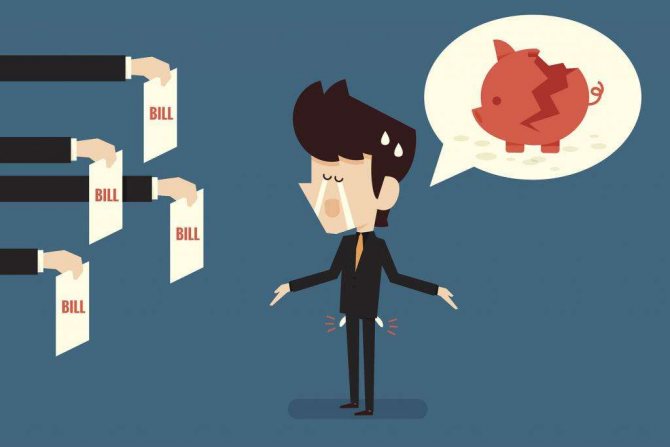Doubtful and bad receivables: how to recognize
From the article you will learn:
1. Why group receivables by probability of repayment.
2. Under what conditions are accounts receivable classified as doubtful?
3. Which accounts receivable are considered uncollectible. How to determine the statute of limitations for debt.
The well-known principle “in the morning - money, in the evening - chairs” in real life works exactly the opposite: as a rule, final payment occurs after the delivery of goods (provision of services, completion of work). Therefore, accounts receivable are an integral part of settlements with counterparties, and in many organizations its value constitutes a significant part of all current assets. The presence of receivables, in itself, is quite common, but do not forget that the amount of such debt shows the amount of funds actually diverted from circulation. In addition, there is always the risk of untimely repayment of debts by debtors or non-repayment at all. Thus, accounts receivable, as part of the organization’s property, requires special attention from the point of view of the principle of prudence: its indicator reflected in accounting and reporting must correspond to reality. To do this, receivables are divided into types depending on the likelihood of their repayment. What types are these, and what are the criteria for classification into each of them - we will consider in this article.
The “reality” of receivables is checked for each debt separately, depending on the time of occurrence and the likelihood of repayment. According to these characteristics, debt can be normal, doubtful or hopeless. Receivables that are not yet due for repayment are considered normal. Such debt is a consequence of the settlement procedure established in the contract, in which final payment must be made within a certain period of time after the delivery of goods (provision of services, performance of work).
Doubtful and bad debts of debtors (these concepts are enshrined in the legislation of the Russian Federation) deserve special attention from the accountant for the following reasons:
- doubtful and bad debts overstate the accounts receivable indicator and the balance sheet currency as a whole, which leads to unreliable accounting statements;
- Doubtful accounts receivable serve as the basis for the formation of a reserve for doubtful debts. In accounting, the creation of a reserve for doubtful debts is the responsibility of the organization, and in tax accounting it is the right of the taxpayer;
- Bad debts of debtors are subject to write-off for both accounting and tax purposes.
Doubtful accounts receivable
What kind of debt is considered doubtful and hopeless under Russian law? In accordance with the Tax Code of the Russian Federation, receivables are doubtful if the following conditions are simultaneously met in relation to them (clause 1 of Article 266 of the Tax Code of the Russian Federation):
- The debt arose in connection with the sale of goods, provision of services, and performance of work.
! Please note: in accordance with the clarifications of the Ministry of Finance of the Russian Federation, receivables not related to the sale of goods, works, services, namely:
2. The debt repayment period established by the contract has expired. If the term is not established in the agreement or the agreement was not concluded in writing, then it can be determined on the basis of the law, other legal acts, business customs, other conditions or the essence of the obligation (clause 2 of Article 314, clause 1 of Article 486 Civil Code of the Russian Federation).
3. The debt is not secured by collateral, surety, or bank guarantee.
For accounting purposes, the conditions for recognizing receivables as doubtful are established by the Regulations on accounting and financial reporting in the Russian Federation No. 34n (paragraph 2, paragraph 70):
- Debt of debtors, regardless of the nature of its occurrence, is not repaid on time or which with a high degree of probability will not be repaid on time.
- The debt is not secured by guarantees.
! Please note: in accounting and tax accounting, the criteria for recognizing doubtful receivables are different.
Uncollectible accounts receivable
Thus, in relation to doubtful accounts receivable, there is a possibility of their repayment. But hopeless (uncollectible) receivables practically eliminate this possibility. Accounts receivable are considered uncollectible if they meet at least one of the following criteria (clause 2 of Article 266 of the Tax Code of the Russian Federation):
1. In relation to the debt, the established limitation period has expired.
2. The debtor’s obligation is terminated due to the impossibility of its fulfillment, on the basis of an act of a government body or liquidation of an organization.
3. The impossibility of collecting receivables is confirmed by the decision of the bailiff to terminate enforcement proceedings in the event of the return of the writ of execution to the collector on the following grounds:
- it is impossible to establish the location of the debtor, his property or to obtain information about the availability of funds and other valuables belonging to him,
- the debtor does not have any property that can be foreclosed on, and all measures taken by the bailiff that are permissible by law to find his property were unsuccessful.
! Please note: If several of the listed conditions are met in relation to receivables, they are considered uncollectible in the tax (reporting) period when the first condition arose (Letter of the Ministry of Finance of Russia dated June 22, 2011 No. 03-03-06/1/373 ).
The most common reasons for classifying receivables as uncollectible are the liquidation of the debtor organization and the expiration of the statute of limitations. In the event of liquidation of the debtor, the debt is considered unrecoverable from the moment the organization is excluded from the Unified State Register of Legal Entities, which is confirmed by an extract from the Register. The procedure for recognizing receivables as bad due to the expiration of the statute of limitations is not so clear, so I propose to dwell on it in more detail.
Statute of limitations
In general, the statute of limitations is three years (Article 196 of the Civil Code of the Russian Federation). The limitation period begins on the date of expiration of the period for fulfillment of obligations by the debtor (payment period) established in the contract. If the contract establishes a procedure for payment in installments, then the limitation period is calculated for each installment separately. If the deadline for fulfillment of obligations is not established, the limitation period begins to be calculated from the moment the debtor submits a demand for fulfillment of obligations.
Example.
The organization LLC "Supplier" shipped the goods to the buyer on July 28, 2014. According to the agreement with the buyer, the final payment deadline was set on August 15, 2014. However, the buyer did not pay for the goods on time. In this case, the limitation period will begin to run from August 16, 2014, and will end on August 15, 2017.
To classify a debt as bad, it must be taken into account that the limitation period may be interrupted in cases where the debtor admits its obligations. After the break, the limitation period begins again. The following actions indicate the debtor’s recognition of his obligations:
- recognition of the claim (applying for a deferred payment, signing a debt reconciliation act, application for offset of mutual claims);
- partial payment by the debtor of the principal debt or interest on the principal debt;
- a change in the contract, from which it follows that the debtor acknowledges the existence of a debt (for example, deferment, installment payment).
! Please note: you can go to court even after the statute of limitations has expired. However, the debtor's statement about the application of the limitation period will serve as a basis for refusing the claim.
Availability of a counterclaim
It often happens that the same counterparty is both a creditor and a debtor at the same time. In this case, the question arises: can such accounts receivable be considered bad, despite the presence of counter accounts payable? The Ministry of Finance of the Russian Federation believes that it is impossible, since the organization can offset mutual claims and, thus, pay off the obligations of the debtor (Letter of the Ministry of Finance dated October 4, 2011 N 03-03-06/1/620). However, the position of the judicial authorities is the opposite: receivables can be recognized as uncollectible regardless of the existence of a counterclaim against the debtor. Indeed, in accordance with the Civil Code of the Russian Federation, offset is a right, not an obligation, which can be used by sending a corresponding application to the counterparty, even unilaterally. And yet, in order to avoid claims from regulatory authorities, it is safer to recognize as uncollectible only that part of the receivables that is not covered by counter accounts payable.
So, we have considered the criteria for recognizing doubtful and bad receivables. In order to assess the probability of repaying each debt separately and attribute it to one type or another, an inventory of receivables is carried out. And based on the results of the inventory, a decision is made to create a reserve for doubtful debts, as well as to write off debts that are unrealistic for collection. Thus, correct determination of the amounts of doubtful and bad receivables will allow you to avoid serious violations of accounting and tax accounting.
If you find the article useful and interesting, share it with your colleagues on social networks!
If you have any comments or questions, write to us and we’ll discuss them!
Legislative and regulatory acts:
1. Tax Code of the Russian Federation
2. Civil Code of the Russian Federation
You can find the Codes of the Russian Federation on the Official Internet portal of legal information https://pravo.gov.ru/
3. Letters from the Ministry of Finance of the Russian Federation:
The current principles of accounting and tax accounting regulate the need to classify receivables according to the likelihood of their repayment.
Counterparties can be different - completely solvent or ready to go bankrupt. In order for all possible risks to be correctly reflected in the primary documentation, you need to know what is meant by doubtful debts and by what criteria they can be determined.
Write-off of doubtful debts
If, in relation to doubtful debts for income, a decision is made to recognize them as uncollectible, such debt is written off from the balance sheet (off-balance sheet) accounting of the institution with a simultaneous decrease in income of the current reporting period (reduction of the reserve for doubtful debts) (clause 11 of the Federal Budgetary Accounting Standards "Revenues" ).
For your information! The Civil Code provides for the following grounds for recognizing receivables as bad:
- expiration of the limitation period (Article 196 of the Civil Code of the Russian Federation);
- impossibility of fulfilling an obligation (Article 416 of the Civil Code of the Russian Federation);
- termination of an obligation based on an act of a state body (Article 417 of the Civil Code of the Russian Federation);
- liquidation of a legal entity (Article 419 of the Civil Code of the Russian Federation).
Thus, if, based on the results of an inventory (another control measure), receivables listed on balance sheet accounts are immediately recognized as uncollectible, they must be written off without being accepted into off-balance sheet account 04.
Doubtful debts are written off from the balance sheet (off-balance sheet) based on the decision of the institution’s commission for the receipt and disposal of assets to recognize the debt as uncollectible if there are documents confirming the termination of the obligation by the death (liquidation) of the debtor, as well as in other cases provided for by the legislation of the Russian Federation, in including upon expiration of the period for possible resumption of the debt collection procedure in accordance with the legislation of the Russian Federation.
The Commission, when deciding to write off the debt of insolvent debtors from the balance sheet (off-balance sheet), has the right to be guided by the provisions of the legislation on the composition of the documents necessary to make a decision on recognizing the debt on payments to the budget as uncollectible and on its write-off (restoration), established by the Budget Code of the Russian Federation, and general requirements for the procedure for making decisions on recognizing debts on payments to the budgets of the budget system of the Russian Federation as uncollectible, approved by Decree of the Government of the Russian Federation dated May 6, 2016 No. 393.
Example 2.
Let’s use the conditions of example 1. Let’s assume that after the expiration of the statute of limitations (3 years), the debtor’s property status has not changed.
In an autonomous institution, the commission for the acceptance and disposal of assets decided to write off from off-balance sheet account 04 a doubtful (bad) rent debt in the amount of 20,000 rubles.
The following entry was made in the accounting records of the institution:
Contents of operation Debit Credit Amount, rub. Doubtful (uncollectible) receivables are written off off-balance sheet Off-balance sheet account 04 20 000
off-balance sheet accounting accounts receivable provision for doubtful debts
What it is
The concept of doubtful debts is regulated by Part 1 of Art. 266 Tax Code of the Russian Federation.
From the regulations you can learn that doubtful is absolutely any debt that has arisen in connection with the supply of goods from one organization to another (performance of work, provision of various services), and which:
- was not repaid by the counterparty within the terms established by agreement of the parties;
- was not provided with one of the forms of security provided for by the Civil Code of the Russian Federation - a bank guarantee, pledge or surety.
In the same part 1 art. 266 provides a slightly different definition of doubtful debt. If a legal entity has both accounts payable and accounts receivable (both in relation to the same counterparty), then the debt can be recognized as doubtful only if the accounts receivable exceed the accounts payable. It is this part (excess) that is doubtful debt.
The Tax Code of the Russian Federation also establishes a special procedure for recognizing doubtful debts for banks and other credit institutions.
If the bank is indebted to legal entities or individuals who took out a loan and did not pay interest on time, then debts in the amount of interest on the loan are recognized as doubtful in any case, even if repayment of the loan is secured by a bank guarantee, pledge or surety.
Tactical approaches in accounts payable
Economic theory and practice considers several possible options for raising borrowed funds. These include:
- bank or financial loan;
- investor funds;
- trade credit;
- use of own cash capital.
Each of these possibilities has its own characteristics and implementation possibilities. Thus, financial loans provided by banking organizations are considered to be one of the most expensive options for credit resources. Factors that limit the desire of legal entities and individuals to seek financial assistance from banks include, first of all, factors such as high interest rates on the loan received and the need to guarantee a real opportunity to repay existing debt in a timely manner and in full. That is, at the time of submitting documents to the bank for issuing a loan, you will have to draw up solid balance sheet calculations with the most realistic indicators. This option allows you to use absolutely the entire amount of money received on credit in your business.
How to determine
Determination of the presence of doubtful debts is carried out on the basis of an analysis of the criteria given in Art. 266 Tax Code of the Russian Federation.
Each counterparty and each unfulfilled obligation must be examined separately - this is necessary both for the purposes of correct tax and accounting.
All transactions with counterparties must be concluded only in connection with the companies’ business activities.
Concluding transactions in the context of other legal relations will cause problems in the future when the debt is recognized as doubtful - the tax authorities may suspect the company of illegally obtaining unjustified benefits.
The Tax Code of the Russian Federation establishes the right of commercial organizations to create a reserve fund. Deductions sent to these funds are classified as non-operating expenses and are subject to accounting on the last day of the reporting period.
Contributions to the reserve fund are regulated by Part 4 of Art. 266 Tax Code of the Russian Federation:
| Duration of the debt (based on inventory data) | Amount included in the reserve |
| More than 3 months | 100% of the debt amount |
| From 1.5 to 3 months. | 50% of the debt amount |
| Up to 1.5 months | 0% of the debt amount |
Criteria for recognizing receivables as doubtful
Recognizing debt as doubtful is necessary not only for tax accounting purposes, but also for accounting purposes. The issue is especially acute when forming a reserve fund for doubtful debts.
There are differences between establishing a reserve for accounting and tax purposes:
| Procedure for accounting | Procedure for tax accounting |
| If there is a doubtful debt, the creation of a reserve is mandatory | The accountant independently decides whether to create a reserve or not. |
| Contributions to the reserve are reflected in other expenses for D-t 91 and K-t 63 | Contributions to the reserve fund are included in non-operating expenses |
| Any receivable that the counterparty has not repaid within the terms established by the agreement and that is unsecured is considered doubtful. | The debt must be related to the supply of goods, sale of services or performance of work |
| The amount of the reserve is established by the accountant based on an analysis of the debtor’s economic situation and the likelihood of non-payment | Deductions are regulated by the Tax Code of the Russian Federation |
| The total amount of contributions to the reserve fund is not limited | The amount of the reserve cannot exceed 10% of the company’s revenue |
On balance
The amount of the reserve in accounting relates to operating expenses. The reserve is created at the expense of the organization’s profit and is reflected by the posting:
| Debit | Credit |
| 61 | 63 |
For the purpose of reflection in the balance sheet, an inventory of debt is carried out at least once a year. Based on the results of the inventory, contractors who have not fulfilled their obligations on time will be identified.
If it is discovered that the debt collection period has expired, or the debtor has been liquidated, then the debt must be recognized as bad.
Debt inventory process and its importance
The above deadlines are determined during the inventory of doubtful accounts receivable. After this operation, the reserve is adjusted as follows:
- If the counterparty repays a debt that was previously considered doubtful, then the amount of the liability is restored, and accordingly, the volume of the reserve is reduced by this amount. In addition, the company will be required to pay income tax, the base of which is the amount of debt received.
- If the counterparty does not repay the debt, then its value is completely written off from the reserve. If it is formed, then the company does not have the right to write off the debt through other means.

Write-off
In order to write off a debt from the company’s balance sheet, it must be recognized as uncollectible (that is, unrealistic to collect).
The Tax Code of the Russian Federation establishes several characterizing features so that a debt can be written off:
- the statute of limitations has expired, when it was still possible to collect the debt from the debtor in court;
- a government agency has issued an act containing information about the impossibility of execution;
- the debtor was liquidated or declared bankrupt;
- enforcement proceedings were terminated on the basis of a bailiff's order: the whereabouts of the debtor are unknown and it is not possible to establish him;
- the defaulter does not have property that could be recovered and used to satisfy the creditor's claims.
The write-off occurs in the tax period in which the basis for it arose.
Let's give an example of how receivables are written off in accounting. PJSC “Investtekhstroy” carried out an unscheduled inventory on June 1, 2016, as a result of which a decision was made to create a reserve fund in the total amount of 62,000 rubles.
A little later, in October 2020, Investtekhstroy’s counterparty was declared bankrupt. Legal relations have developed between organizations for the supply of essential goods.
A debt in the amount of 80,000 rubles was recognized as bad on the basis of the liquidation of the debtor company.
The accounting service of Investtekhstroy reflected financial transactions in accounting with the following entries:
| Debit | Credit | Operation | Sum |
| 91/2 | 63 | Creation of a reserve for doubtful debts | 62000 |
| 63 | 62 | Writing off part of the bad debt | 62000 |
| 91/2 | 62 | Write-off of the part of the debt not covered by the reserve fund | 18000 |
| 76 | 68 VAT | VAT accrual on the amount of debt written off | 14400 |
What documents are needed to write off a debt?
To identify bad debts, an inventory is carried out.
Keep in mind that the inventory report and one order from the director issued based on its results are not enough to write off the found bad debt as an expense.
Primary documents are needed confirming the formation and existence of receivables, based on the specifics of the transaction (see, for example, the Resolution of the Arbitration Court of the North-Western District of December 9, 2016 in case No. A21-8523/2015).
For each case of writing off a bad debt, you will need documents on the transaction, from which you can see the amount of the debt and the date of its formation.
Here is an approximate list of documents for writing off a bad debt:
- acts of inventory of settlements with buyers, suppliers and other debtors and creditors;
- written justification for debt write-off;
- order (instruction) of the head of the organization to write off the debt;
- an agreement that specifies the due date for payment;
- invoices, acceptance certificates for services rendered;
- documents confirming payments (payment orders, statements, orders, etc.).
You also need papers that confirm the occurrence of circumstances under which it is allowed to classify debts as bad (clause 2 of Article 266 of the Tax Code of the Russian Federation):
- resolution of the bailiff on the completion of enforcement proceedings;
- court decisions, decisions of government authorities;
- extract from the Unified State Register of Legal Entities on the liquidation of the debtor organization.
Reserve
When creating a reserve, the following nuances must be taken into account:
- The reserve fund is formed only based on settlements made with other counterparties for shipped products, goods sold, and services provided. The amounts of listed advances for suppliers are not subject to inclusion in the fund. This means that the reserve fund is formed only for the debts of customers (buyers).
- The reserve is created based on the results of a scheduled or unscheduled inventory.
- The size of the fund is established based on the analysis of each doubtful obligation separately, based on the economic and economic condition of the debtor and an assessment of the risk of non-payment of debt, both in full and in part.
After the creation of the fund, the company is obliged to constantly monitor the movement of those obligations for which the reserve has been established, since accounting entries are formed in the context of analytical accounting for each individual debtor.
Based on clause 4 of PBU 21/2008, contributions to the reserve fund are changes of an estimated nature. Reflection in accounting is carried out as part of the expenses of the period within which the corresponding changes occurred.
Thus, contributions to the reserve fund are subject to reflection in accounting at the frequency with which the enterprise’s accounting policy requires it (Article 15 of Federal Law No. 402).
Some nuances of reflection in accounting:
- the amount of reserves is reflected in debit 91 and credit 63;
- the write-off of a bad debt, which was previously recognized as doubtful, is reflected in the accounting entries as debit 63 and credit 76;
- bad debt in an amount that exceeds the reserve fund is written off as the debit of account 91;
- an obligation written off after the statute of limitations has passed is displayed on off-balance sheet account 007;
- if the counterparty pays a debt for which a reserve was previously formed, the corresponding amounts of reserves must be restored by debit 63 in correspondence with account 91;
- within 5 years after writing off the obligation, it must be monitored in order to identify the possibility of collecting it while restoring the proper level of solvency of the debtor.
The sale of receivables in bankruptcy proceedings is discussed in the article: sale of receivables.
About untimely write-off of accounts receivable.
On what date should a bad debt be written off?
The Tax Code does not directly establish a special date for writing off bad debt and reducing the tax base for income tax. Based on practice, the most acceptable is the last day of the reporting or tax period in which the debt is recognized as bad (subclause 3, clause 7, article 272 of the Tax Code of the Russian Federation).
In turn, the date of recognition of the debt as uncollectible will be the date of drawing up the corresponding document, the date of making an entry in the Unified State Register of Legal Entities on the liquidation of the organization, the date of drawing up the act of the state body, the date of the bailiff's decision on the completion of enforcement proceedings.
If bankruptcy proceedings have been opened against your debtor, then they are considered completed from the date of making an entry on the liquidation of the debtor in the Unified State Register of Legal Entities (Article 149 of the Federal Law “On Insolvency (Bankruptcy)”).
A bankrupt's receivable can be considered hopeless after completion of bankruptcy proceedings and an entry in the Unified State Register of Legal Entities about its exclusion from the register (Letter of the Ministry of Finance dated March 18, 2020 No. 03-03-06/1/17813).
Certificate of absence
A certificate of absence of doubtful debts may be required by companies for various purposes - for example, to attract a new investor, or when collecting documents for a tender.
The tax authority that registered the legal entity-taxpayer is responsible for issuing the certificate.
To do this, the taxpayer submits a request to the Federal Tax Service in free form or according to a generally accepted template. request is possible .
You can request information not only regarding the status of settlements, but also about the fulfillment of obligations to pay taxes and fees. These are different certificates, so the required type of document must be checked in the request.
When requesting a certificate, you need to take into account that even the presence of a small debt to pay taxes to the budget may entail the issuance by tax authorities of a statement that the organization has unfulfilled obligations to pay taxes.
And such a document will no longer allow the organization to achieve the goals that it pursued.
Thus, a certificate of no debt allows you to identify at an early stage how much taxes were not paid to the budget, whether accounting operations were carried out correctly and income tax was calculated.
After repaying all obligations to the state, you can contact the Federal Tax Service again - this time to request a “zero” certificate, which will indicate the full repayment of obligations.
So, according to the degree of probability of its repayment, the receivable is divided into doubtful and hopeless. Doubtful debts include any debts related to goods, services and works that are not repaid on time and are not properly secured.
Organizations have the right to create reserve funds - in such cases, the debt will be covered by part of the funds from the fund, and the rest will be written off (if it is recognized as unrealistic for collection).
For information on purchasing receivables at auction, read the article: purchasing receivables.
You can sample a statement of claim for collection of accounts receivable.
The procedure for conducting an inventory of receivables is described in this article.
The impact of accounts receivable on business
The issue of the impact of the presence of accounts receivable on business is controversial. On the one hand, it allows you to significantly expand your business opportunities. The entities with which the company interacts do not always have sufficient funds to fully pay for goods and services. Then remote sensing is one of the few means that makes interaction possible.
You will be interested in: How to recognize a house as unsafe, where to go? Home inspection
However, it must be remembered that accounts receivable is the cost of goods that were sold but not paid for, or materials that were purchased but not received for use. Accordingly, it always causes the diversion of funds from circulation, their temporary death. Consequently, if the volume of accounts receivable is too large, this does not contribute to the development of the business, but rather, on the contrary, hinders its expansion. In addition, there is always a risk that the debt will not be repaid, which inevitably leads to financial losses and can even lead to bankruptcy of the company. For this reason, the permissible amount of debt must be approached extremely carefully, carefully weighing all the risks and possible benefits.

Overdue accounts receivable
Accounts receivable are the obligations of buyers and customers to reimburse funds to an organization or individual entrepreneur for services rendered, products sold, etc. Any relationship between buyer and seller must have a legal basis.
Most often, organizations charge payment for their services and goods after transferring them to the counterparty. This is where debt arises. At its core, accounts receivable are an organization’s asset just like any other. Therefore, there is a need for control, since it is possible to overestimate the amount of debt.
Doubtful accounts receivable in accounting and tax accounting
The definition of what doubtful accounts receivable is, as well as the main criteria for its definition, are given both in tax legislation and in the explanation of the accounting regulations.
| Accounting | Tax accounting |
| The debt arose due to violation of deadlines for fulfilling contractual or legal obligations, regardless of the reason for its occurrence | The debt arose due to violation of deadlines for fulfilling contractual or legal obligations, only for transactions related to the sale of goods or services, nothing more |
| The debt is not secured by any of the possible guarantees | The debt is not secured by any of the possible guarantees |
| ★ Best-selling book “Accounting from scratch” for dummies (understand how to do accounting in 72 hours) > 8,000 books purchased |
What are accounts receivable and when do they arise?
You may be interested in: Additional payment for night hours: calculation procedure, rules and features of registration, accrual and payment
In the course of business, a company often has to interact with customers who purchase its goods and services, and suppliers who provide materials and components for a fee. Receivables (accounts receivable) arise during this interaction in the following cases:
- The company has transferred goods to customers, but has not yet received revenue for these goods. The customer is expected to pay for the item at a later date.
- The company paid for the materials, but has not yet received them. The supplier is expected to deliver the materials at a later date.
You may be interested in: Consent of a spouse to purchase real estate: rules for drawing up and validity period
Channel PROGRAMMER'S DIARY
The life of a programmer and interesting reviews of everything. Subscribe so you don't miss new videos.
That is, we can say that if a company has a debt, then there are economic entities that owe it something. It is important not to confuse accounts receivable with accounts payable. The presence of the latter means that there are economic entities to whom this company owes money. At the same time, accounts receivable from one company are often accounts payable from another.

Creation of a reserve for doubtful debts
After conducting an inventory of existing debts, the organization is obliged to turn its attention to those whose repayment dates are overdue by more than 45 days. An inventory must be taken at the end of each reporting period. The presence of doubtful debts obliges the accountant to create a reserve for these debts. However, there is only one exception when there is no need to create a reserve - this is the presence of a notification from the debtor about the imminent repayment of the debt.
The process of forming a reserve must be regulated by the internal accounting policies of the organization.
The reserve, at its core, is an estimated value that is formed to adjust existing debt in order to prevent distortion of data used for accounting and tax accounting. The reserve is created subject to the following tax accounting rules:
- The reserve is formed only for transactions related to the sale of finished products, goods, services, construction and installation work, etc. Therefore, debts on advances, fines and penalties, other transactions, etc. cannot be included here.
- The reserve is created upon completion of an inventory of the organization’s existing debts;
- The amount of the reserve should be determined separately for each debt, taking into account actual data: repayment date, solvency of the counterparty, civil relations with the counterparty, etc.
Use (restoration) of the previously created reserve for doubtful debts
All any changes that occur with existing debts are reflected in the amount of the previously created reserve. This means that in the case when a debt for which a reserve had already been created earlier, for justifiable reasons, passes into the category of bad debts based on the inventory carried out and subsequently generated orders, the debts are written off as they are recognized as non-operating expenses.
At the same time, it is necessary to recall that these debts do not disappear anywhere after being written off as losses; accounting keeps them in a specially created off-balance sheet account.
At its core, this operation is an adjustment to the estimated value, just as the repayment of the debt itself affects the amount of the created reserve. The only difference is in the accounting entries that the accountant creates for each specific operation based on its functional meaning.
Determining the amount of debt taken into account when creating a reserve
Now it is necessary to figure out what amount of debt is required to create an estimated liability. The amount of debt taken into account when creating a reserve depends on the period of occurrence of the debt. This aspect is regulated by tax legislation. The total amount of the estimated liability created by the accounting department on the basis of internal legal acts cannot be more than a tenth of the organization’s total revenue for this period (see → creation of a reserve for doubtful debts in accounting + postings in 2020).
| Date of occurrence | Debt amount |
| Exceeds 90 days from the date of violation of the deadline for fulfilling payment obligations | The reserve takes into account the entire amount of debt |
| From 45 days to 90 days | The reserve takes into account only half of the amount of existing debt |
| Debts up to 45 days | With this period, no reserve is created |
Accounting entries to create a reserve for doubtful debts:
| Debit | Credit | Description |
| 91 | 63 | Creation of a reserve for doubtful debts |
| 50 (51) | 62 (73, 76…) | Repayment of existing debt by the counterparty |
| 63 | 91 | Restoration of a previously created reserve after repayment of debt |
When does it occur?
There are a number of reasons that allow us to talk about doubtful debts.
In order for such a phenomenon to occur, two basic conditions must be met:
- Within the period of time that was specified in the contract, the funds were not returned.
- The taxpayer does not have any leverage over the debtor. That is, the funds were issued without providing collateral that could be realized, a guarantor bearing joint and several financial liability, and no bank guarantees were provided.

In case of doubtful debt, the debtor has the right to collect debts from the creditor in court. In turn, the opponent can file a counterclaim to contest the debt
If both of these conditions are met, the debt may be considered doubtful and a reserve is created for it. Moreover, to recognize it as such, the accountant does not have to wait until it is overdue. If there are circumstances indicating that payment will not be made, an employee of the enterprise can take the necessary actions in advance.
The fact that there are accounts receivable is also important. That is, this phenomenon can only arise as a result of non-return of money when:
- sales of certain products;
- provision of various types of paid services;
- performing certain work.
Reference. If the buyer does not pay the funds for the goods sold, work performed, or service provided, his debt may be considered doubtful.
Meanwhile, it must be borne in mind that a reserve cannot be created if the debt arose:
- on prepayment for goods in the absence of shipment by the supplier;
- due to the application of penalties associated with violation of the conditions specified in the contract.
For better understanding, a specific example should be given. Let's imagine that we have completed certain work for. According to the contract, the cost of these works is 150,000 rubles. After the allotted period, the money was never paid. This is dubious debt.
In order to resolve the issue of tax collection, the accountant of enterprise “A” creates a reserve for it, since the signed agreement did not provide any guarantees of the return of funds (meaning a pledge, etc.). Its size will depend on the total revenue for the quarter in which the services were provided and the duration of the debt obligations.

Creating a reserve for doubtful debts will show in accounting a real picture of the financial situation in the organization
Regulatory documents governing the accounting of doubtful debts
Accounting and control of doubtful debts for organizations is quite an important process and is most often associated not only with accounting and tax accounting as such, but also with civil legal relations between the buyer and the supplier.
| Code name | Article | Description |
| tax code | 266 | The article regulates the formation of a reserve for doubtful debts; the article also indicates the main signs of bad debts |
| Order of the Ministry of Finance | 34 | The article regulates the basic principles of accounting, provides clarification and clarification of points that were not included for any reason, including provisions on doubtful debts |
| Civil Code | 486, 314 | The article regulates the legal framework for compliance with obligations to fulfill contractual relations |
| Civil Code | 196 | In the article you can find the necessary information about the statute of limitations. |
Declension of the noun debt
| Case | Question | Unit | Mn. number |
| Nominative | (who what?) | debt | debt |
| Genitive | (who, what?) | debt | debts |
| Dative | (to whom; to what?) | debt | debts |
| Accusative | (who, what?) | debt | debt |
| Instrumental | (by whom, what?) | debt | debts |
| Prepositional | (About who about what?) | debt | debts |
Reflection of doubtful debts in 1C
Currently, almost all organizations keep records of their activities in specially purchased software adapted to various legal and functional nuances inherent in this particular organization. These software simplify record keeping, error detection, information storage and aggregation of existing data.
In accordance with accounting, the reserve for doubtful debts in the specialized 1C program is reflected by filling out the appropriate tabs on the debit of account 91.02 and on the credit of account 63, where the amount (amount) of the reserve being created is also indicated.









